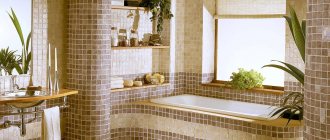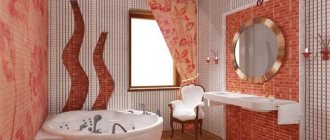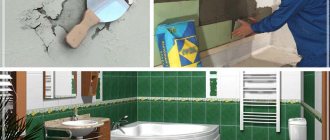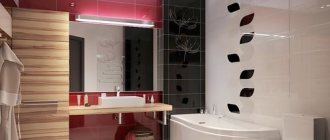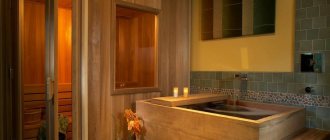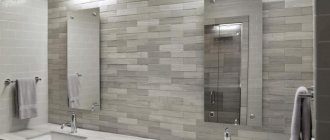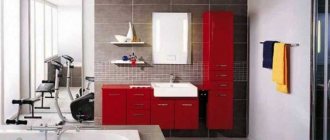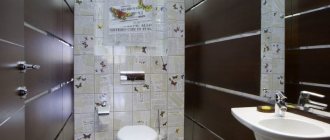Choosing material
When choosing ceramic tiles for the bathroom, you need to take into account the composition and moisture-resistant parameters of the material. Blocks are divided into ceramic, glass, porcelain stoneware. Collections are produced for floor surfaces, walls, sets with accessories in a single color scheme.
For tiles in bathrooms and toilets, the following are important:
- resistance to abrasion and mechanical stress;
- ability to withstand temperature changes;
- strength;
- resistance to cleaning agents with acid-base composition;
- durability;
- color fastness, preservation of the geometry of ornaments;
- anti-slip characteristics;
- low water absorption (10-15%).
Ceramic tile
Ceramics for the bathroom are aesthetically pleasing, strong, durable, and budget-friendly. Finishing blocks differ in purpose, manufacturing technology, composition, design, and color schemes.
Clinker blocks are the most durable, moisture-resistant, resistant to temperature changes, and easy to clean.
The material has a matte texture and is available in a range of natural brown and reddish shades. The collections feature imitations of brick, wood, and products with aged surfaces.
Glazed slabs are moisture-resistant, durable, allow you to create original ornaments, and are distinguished by glossy surfaces and rich shades.
Cotto slabs are made of red clay and are not glazed. When installed in a bathroom, the blocks must be treated with a hydrophobic compound to preserve the porous surface.
Monocottura slabs are used to finish the walls and floors in bathrooms. The products are distinguished by rich shades and decorative patterns.
Bicottura ceramics are distinguished by natural, dusty shades, suitable for decorating bathtubs in classic, Provence, and country styles. The product is optimal for wall finishing; the material is not dense enough for flooring.
Glass tiles
Glass slabs are aesthetic, moisture-resistant, durable, and hygienic. The material is used to create color accents in a room and can be combined with tiles, wood, polymers, and metal. Glass blocks can be frosted or transparent and are available in different sizes.
The material can be tinted, complemented by engraving, artistic painting, and ornaments.
Thin glass blocks are not recommended for laying on the floor; the coating is not wear-resistant and stable enough.
The elements are used to create complex mosaic installations.
Glass inserts make small bathrooms appear larger. The slabs can be laid diagonally, in a checkerboard pattern. The wall decoration can be solid or combined with monochrome tiles. The material is durable, easy to clean, and resistant to corrosion and mold.
Porcelain tiles
Porcelain stoneware slabs are the most durable, wear-resistant, and durable.
The materials are recommended for finishing floors and walls in spacious bathrooms in residential and public spaces.
The plates are resistant to abrasion and chipping. Manufacturers offer a wide palette of natural shades with matte and glossy textures. In terms of homogeneity of composition and resistance to changes in temperature conditions, the material corresponds to stone rocks. The boards are easy to clean and resistant to plaque and mold.
What size tiles should I choose for a small bathroom?
If you take into account a few subtleties, you can lay tiles of any size. To complete the finish, it is advisable to combine different products. But in the end, it all depends on the preferences of the apartment owner, even if it is a small bathroom in a Khrushchev-era building.
- Large products (for example, 30x40) are laid horizontally; this method will visually expand the walls. The grout for the joints should be chosen in a tone so as not to split the space with thin contrasting lines.
- Medium sized tiles (20x30, 30x30) are the best option for a small bathroom.
- Products of small sizes (these include “boar” 10x20 and square 10x10) can split up the space if you use different colors and contrasting grout. It is recommended to choose a single-color material, due to which the room will visually come together.
The photo shows large-format tiles with inconspicuous grout to match.
- Mosaics are usually used to decorate one wall or, for example, a shower stall. If you want to decorate the entire room with mosaics, it should be the smallest and lightest shades in order to create a general background without affecting the geometry.
The photo shows a combined bathroom, the walls of which are decorated with ceramic mosaics interspersed with mirror ones.
Determining the dimensions
When choosing a bathroom coating, the shape and size of the blocks are important. Manufacturers produce slabs of standard and non-standard dimensions. The list of popular ones includes rectangular slabs 100x100, 150x150, 300x300, 75x150 mm.
To create glass inserts, square elements 65x65, 100x100 mm are used. Mosaic installation is carried out with slabs of 10x10, 20x20, 20x40, 30x30, 48x48 mm.
In a small bathroom it is recommended to install medium-sized blocks, because... mosaic elements visually narrow the room. The optimal size of square blocks is 20x20 cm, rectangular - 20x30 cm.
In the design of large rooms, slabs of different sizes and configurations can be used.
Size selection
Standard ceramic tiles are produced in the following options - 10 by 10, 15 by 15, 30 by 30, 7.5 by 15 centimeters. This applies to tiles. Mirror inserts are usually square in size - 6.5 by 6.5, 10 by 10 centimeters. And finally, there is also a mosaic, which is naturally smaller in size - 10 by 10, 20 by 20, 20 by 40, 30 by 30, 48 by 48 millimeters.
The size of the tiles should directly correlate with the dimensions of the bathroom itself. For a small room, a universal option is 20 by 20 centimeters. Experts also advise paying attention to rectangular tiles. If you place it vertically on the walls, it will visually increase the height of the ceilings. And if it’s horizontal, then the dimensions of the bathroom itself will seem enlarged. Lastly, don't forget about glass inserts. They also visually expand the size of the room. By the way, for the same reason it is recommended to install a large mirror in the bathroom.
If the bathroom is spacious, then your imagination is unlimited. Feel free to experiment with tile sizes as you wish.
Choosing a style
Before choosing tiles for your bathroom, you need to determine the style of the room. The color scheme, decor, type of installation and size of the slabs are selected for the design.
Popular trends in bathroom interior design:
- classic;
- Provence;
- loft;
- minimalism;
- country;
- high tech.
Classic
Classic design is universal and aesthetic. The standard option involves finishing the upper part of the wall with slabs of light shades, the lower tier is filled with cladding 2-3 shades darker. The area where the surfaces join is decorated with border tiles with geometric patterns. The flooring is decorated with slabs of dark shades. A light floor finish will visually expand the room.
To implement a classic design, natural materials are recommended (ceramic granite, marble, glazed blocks). The interior color scheme includes white, dark brown, pastel and beige colors. Geometric patterns complement the monochromatic palette.
During installation, parquet laying techniques, “herringbone”, and “checkerboard” are used. The interior is complemented by bronze-decorated bathtubs, candlesticks, and taps. Bronze-plated inserts can be included in wall slab installations.
East style
The eastern direction of design is distinguished by the use of bright colors in decoration. The style involves the use of slabs with elegant ornaments (stylized flowers, birds, Turkish cucumber). The decoration combines slabs of rich blue, golden, dark green, red, bright blue, and yellow.
The oriental style is distinguished by the inclusion of mosaic decor when decorating walls, ceilings, floors; patterns also decorate equipment (bathtub, sink, stands). The decor is optimal for spacious rooms.
It is not recommended to carry out continuous mosaic laying in rooms with a combined bathroom.
Small bathrooms are decorated with medium-sized slabs, and the decoration is complemented with ornamental inserts.
Provence
To implement a bathroom project in a Provençal style, you need to use the following shades:
- lilac;
- lavender;
- beige;
- olive;
- baby blue;
- citric.
White or milky plaster is recommended as a background for the slabs. The surfaces of the plates can be glossy, matte, textured. In addition to plain elements, the installation includes blocks with floral patterns, aged surfaces, decoupage, engraving, and wood stylization.
The slabs are decorated with images of compact bouquets, rural scenes, herbs, and flowers.
Minimalism
Bathroom design in a minimalist style involves the use of restrained colors. For finishing, blocks of standard sizes, monochrome or with inclusions of geometric patterns, are used.
Laying is carried out according to classical schemes. A combination of 2-3 shades in the interior is allowed. Optimal matte surfaces are included in the finishing of slabs imitating natural wood.
Loft
To decorate a loft-style bathroom, tiles imitating the texture of brick, concrete, and metal surfaces are used. The inclusion of blocks with the effect of aged surfaces is popular.
Industrial style involves combining surfaces with different textures. Several walls are decorated with brickwork, the partition can be stylized with metal slabs.
Restrained surface shades (gray, beige, white) can be complemented by slabs with street art drawings in bright colors, reproducing graffiti, and spectacular posters.
When implementing the project, the stylization of unpainted plaster and aged brickwork is used. The flooring is laid with porcelain stoneware blocks symmetrically or with a slight offset.
The design of a loft-style bathroom may include blocks stylized as untreated wood. The slabs must be large in size to create the effect of a plank floor.
Popular Tile Design
We can say that the number of design decisions for finishing bathrooms far exceeds the number of designers, since most of the options are made by the homeowners themselves, taking into account the recommendations of experienced craftsmen. Therefore, this article will only list a few of the best uses for floor and wall tiles from different price categories. In these designs, the set consists not only of the slabs themselves, but also includes borders, panels and mosaics.
Bathroom in Provence style
This is perhaps the most popular bathroom finishing style. The main distinguishing feature of this style is the light neutral tones. Here they use milky, cream, beige, blue, light green, pink tiles.
The interior of the room is calm without bright, eye-catching elements. Floral inserts are used quite often. The color of the flooring is only 1-2 shades darker than the walls. A border must be placed at the junction of the wall and the floor. An effective solution could be to use porcelain stoneware that imitates wood.
"Loft"
Modern stylish interior in brown and coffee colors. Wooden motifs are welcome. The main design accents are aimed at the upper part of the walls, but the floor is somewhat lighter. The Loft style is distinguished by its pronounced minimalism and even asceticism, expressed in the absence of additional decorations and decorative elements.
Glossy and semi-matte tiles are not used. Only matte and often textured material is placed on the floor and walls. Porcelain stoneware is also used, not only as a floor covering, but for wall decoration. In addition, clinker tiles are very popular.
Natural motives
A bathroom decorated in the Natural Motifs style is not necessarily done in green tones. Oddly enough, the most suitable options are wood, beige and sand shades.
But green tiles are used only to highlight a few accents. The total area of green color rarely exceeds 20% of the entire finishing surface. For the floor, you can use bright accent colors or those that match the walls, but are darker.
"Romantic"
This style works well for small to medium sized bathrooms. It cannot be used in combined bathrooms, since the presence of a toilet in a romantic design looks simply ridiculous.
The decoration is simple. The most popular options contain floral motifs in pink, lilac, crimson or purple tones, but the red color is perceived as aggressive and is practically not used. The floor almost matches the walls in color.
Sea style
This is also a very popular and widespread option for finishing a bathroom. It gives the widest scope to your imagination. The main shades are blue, cyan, aquamarine, turquoise and, of course, sea green. Some dilution with sand and green tones is allowed, especially in the lower part of the wall. Interesting solutions are provided by volumetric tiles with 3D images, as well as mosaic inserts.
Choosing a color
When selecting the color scheme of a room, the dimensions, style direction, and location of plumbing equipment are taken into account.
Neutral slabs of white, milky, and ivory colors are universal in bathroom design. The design solution is recommended for compact spaces, because... will visually enlarge the room. Monochrome blocks can be combined with bright decorative elements with ornaments.
A classic color scheme is a room decorated in blue tones. The design uses slabs of turquoise, blue, and purple shades. Slabs of white and silver shades will set off the rich colors.
A popular design solution is a bathroom in green tones. When laying, slabs of light green, pistachio, emerald, and malachite shades can be combined. You can complement the design with elements of beige, white, and sand shades.
The bathroom, decorated with slabs of burgundy, red, lilac, violet shades, is complemented by white and pastel elements. Combinations of pink and crimson shades with fuchsia inserts look impressive. Surfaces can be matte or pearlescent.
Finishing the walls and floors with slabs of coffee and beige shades helps create a comfortable environment. The design is complemented by the inclusion of solid wood imitation blocks. Bright accents can be created by including golden, turquoise, terracotta colors.
The classic option is the combination of white and black. The finish can be complemented with chrome elements and inserts of silver mosaic tiles.
Choosing a color scheme
The color of the tiles affects the overall impression of the bathroom. It should not be too bright, irritating or putting pressure on the eyes. The main thing is to make the bathroom feel comfortable and create a special mood - the right color can successfully cope with this:
- White tiles in the bathroom are a neutral classic that some people find too boring. However, this color is the best thing you can come up with to expand a small space. Moreover, white tiles can be combined with any other shade, creating a variety of wall compositions. The only thing you should avoid is pure white, cold color, which causes strong associations with hospital walls. There are many other variations: ivory, creamy ice cream, baked milk, etc.;
- Blue or green tiles – creates a feeling of coolness, freshness, and energizes you;
- Coffee, beige, “woody” shades - soothe, give the bathroom coziness and warmth;
- Rich shades of turquoise, gold, red are used mainly to create accent motifs. A bathroom completely tiled with too bright tiles will cause emotional stress;
- Black tiles reduce space and have a depressing effect. If the bathroom does not have a window, then dark cladding will significantly enhance the feeling of a closed, “oppressive” space. In addition, dirt is especially visible on black tiles: traces of water, varnish, and detergents.
White tiles in this bathroom don't look boring. Light green inserts on a white background remind you of the purity of a spring morning and charge you with freshness
Deciding on the surface
When deciding which tile is best to choose for the bathroom, you can determine the texture from the photo.
Floor slab coatings for rooms with high humidity must be safe, with an anti-slip effect.
According to the appearance of the product there are:
- matted;
- glossy;
- textured (with imitation of stone, untreated wood, pebbles, metal).
Glossy tiles
Slabs with glossy surfaces are often used in bathroom decoration. Special compounds are applied to the blocks, which after heat treatment provide strength to the products. The coatings are easy to maintain, reflect glare of light, and visually expand the space. Glossy products are available in a wide range of bright and pastel shades.
However, it is necessary to take into account the instability of smooth surfaces; blocks are not recommended for floor finishing. The material is used in the design of walls, ceilings, and furniture.
Matte tiles
Boards with a matte surface are not subject to additional processing or glazing.
The advantage of the products is their rough texture, which ensures safe operation in rooms with high humidity.
Mineral chips are applied to some blocks, giving the coating a shimmering shine.
The products are more durable, reliable, wear-resistant, and can withstand mechanical loads. However, it is necessary to take into account the greater moisture absorption of the porous surface.
The color range of matte products is neutral, dusty, the blocks are optimal for laying out the background for collages and mosaics.
Mirror tiles
Mirror plates are decorative, moisture resistant, and easy to clean. The material allows you to visually expand the bathroom space. Plates are used to decorate solid surfaces (ceilings, walls) or combined with monochrome blocks. Using large elements, you can mount the mirror on the wall.
A diagonal layout on the walls and flooring will visually lengthen the space. Installing mirror material on the ceiling will visually increase the height of the room.
We choose live
The first thing you need to remember forever is that tiles cannot be selected from photos from the Internet or in magazines. From the photographs you can only determine the size and color, and even those will be distorted. So you definitely need to go to the store. And be sure to touch all the tiles with your hands. This way you will appreciate the texture and geometry of the edges.
You will also understand how the tiles fit together. And will there be any gaps between them? Take it, apply it and see. And don’t trust ready-made stands. Most of them do not reflect reality, since the tiles are installed with liquid nails, and not with special glue, and there is no grout.
And don't listen to sales consultants if they start talking about the possible design of your bathroom. They were not hired for this knowledge (they may be completely absent at all). And behind the external desire to help, there may be an attempt to sell you either stale goods or expensive (and often very tasteless) decor.
And one more piece of advice. You don't have to buy tiles right away. Still, there are a lot of options reviewed, and it’s easy to get confused in them. Experts advise taking photographs of all the options you like, and then evaluating them again at home in a calm environment. And when you decide, you can go back to the store to do your shopping.
Choosing a laying method
Before choosing tiles for the bathroom and toilet, you need to determine the method of laying the material. In accordance with the method, square, rectangular or polygonal products are required. The design influences the selection of glue, plaster, and grout.
Installation of slabs is carried out:
- diagonally;
- brickwork;
- "herringbone";
- mosaic;
- "kaleidoscope".
The finishing can be done using single-color blocks or supplemented with inserts with ornaments, painting, and engraving.
Brickwork
Laying under a brick wall is used in different design directions (country, loft, modern, classic).
Finishing one surface in monochrome will visually expand the room and create a cozy space.
Brickwork is popular in antique-style rooms. It is possible to combine brick-like slabs and a plastered surface in a classic style. In vintage interiors, brick blocks can be combined with smooth tiles.
Easy installation
Basic installation is the easiest to perform. The method is optimal for floor design and does not involve displacement of elements. A symmetrical layout of elements requires leveling the floor surface.
During installation, experts recommend using large slabs; it is possible to include contrasting elements. When finishing a compact bathroom, installation is done using medium-sized slabs.
Diagonally
Diagonal laying is aesthetically pleasing, visually lengthens the room, and is advantageous in monochrome interiors. During installation, a diagram and calculation of the material, surface marking, and adjustment of elements are required.
The laying method allows you to hide uneven perimeter and surface imperfections. The design is recommended for flooring in classic, modern, and baroque interiors.
Herringbone
The herringbone layout is used in the design of floor surfaces, but is not recommended for walls. For the bathroom, choose porcelain stoneware or ceramics with wood, stone or plain finishes.
For finishing, elongated rectangular slabs are used. It is possible to use blocks of several shades and sizes.
Wood-look boards will create an imitation of parquet; the method is optimal for spacious rooms. It is possible to include inserts with ornaments in vintage-style rooms.
Mosaic
Mosaic tiles allow you to implement complex design solutions indoors. The material is strong, moisture-resistant, durable, and can withstand high temperatures.
Blocks are produced in different shapes, sizes, and colors. Plates are produced in the form of squares, rectangles, circles, rhombuses, and polyhedra.
Blocks are used to create accents on walls, flooring, and interior items. The small dimensions of the products allow installation on uneven surfaces and curved planes.
It is possible to create ornaments and artistic images. Complex installation of products must be taken into account.
Bathroom tile size
Tiles are consistently selected according to 3 main parameters:
- size;
- form;
- design.
The correctly selected size of bathroom tiles will visually help expand the boundaries of a small room and highlight the advantages of a large one. In general, the entire range can be divided into groups by size:
- small squares - elegant tiles with sizes from 60 to 120 mm, in increments of 30 mm, thickness - standard 7-10 mm;
- medium and large squares — tile sizes from 180 to 600 mm, thickness increased to 10-15 mm, for greater fracture strength;
- hog - a narrow rectangular tile with overall dimensions of length 120-300 mm, width 60-150 mm, tile thickness 7-9 mm;
- large rectangles - tiles ranging in size from 200*800 mm and larger, laid using a special “joint to joint” technology, the coating looks seamless.
When choosing a tile size, you need to consider several nuances:
- The large size of the tile means its significant weight. For flooring this is not critical, but for wall cladding it can be a decisive parameter. You will need a special glue with enhanced adhesion.
- Laying small-sized tiles increases the time required for both laying and grouting.
You can follow the rule: for a spacious room, use large format tiles, and for small rooms, select combined options to change the perception of a small space. To do this, you need to decide on the shape of the tile.
Why shouldn't you use borders?
When decorating modern interiors, borders are not used. The elements were used for rooms with a standard height. In modern residential complexes, ceiling heights vary and adding a decorative insert of 5 cm can lead to asymmetrical laying of the main blocks.
In rooms with suspended ceilings, the height is adjustable; when laying slabs, you can trim elements and not add borders.
Experts do not recommend using borders to separate light and saturated backgrounds, because... If the horizontal line is not observed, the repair will turn out to be unaesthetic. A narrow insert may not fit the overall design of the room. Additional joints can lead to deformation of the coating and disruption of the composition.
Choosing a manufacturer
In the ranking of popular companies producing bathroom tiles, domestic and foreign manufacturers:
- Kerama marazzi;
- Cersanit;
- Fap ceramiche;
- Unitile;
- Keramin;
- Golden tile.
Kerama marazzi
The Kerama Marazzi company offers collections of ceramic products, porcelain stoneware blocks with different textures, shades, and patterns. The company also produces product lines with imitation of solid wood of different species, brickwork, stone, and genuine leather. The products in the collections are monochrome, with ornaments and paintings.
Cersanit
The manufacturer Cersanit produces more than 20 collections of porcelain stoneware blocks and about 30 selections of ceramic tiles for bathrooms. Blocks are presented with glaze, matte, with textured images, in bright and pastel shades.
The company produces a comprehensive line of products for bathroom design. Products are manufactured using European technologies and are certified.
Unitile
The Unitile company produces about 30 collections of ceramic tiles for bathroom decoration. Popular block sizes are 33x33, 60x60 cm. The collections feature universal products in different shades. Products are high quality and affordable.
Fap ceramiche
The Fap Ceramiche company (Italy) specializes in the production of slabs for bathrooms and offers customers more than 30 collections. The company produces environmentally friendly products from natural ingredients that feature an original design.
The line includes blocks with imitation of precious woods and stones. The products are distinguished by their quality, resistance to abrasion and ultraviolet rays, and do not lose color brightness.
Golden tile
The Golden tile company (Ukraine) presents budget and mid-price collections. The enterprise has a raw material procurement base, a design bureau, and uses modern technologies (digital printing). The company's product range includes more than 60 collections of slabs. Standard sizes are represented by blocks of 20x30, 25x40, 30x60, 15x60, 30x30, 40x40 cm.
Keramin
sells products in the mid-price category. Buyers are offered more than 80 collections (“Venice”, “Tokyo”, “Sakura”, “New York”). There are several color solutions for ornaments and graphic designs.
The manufacturer offers slabs with landscape images. The products are durable and wear-resistant.
How to make an unusual floor?
When implementing a bathroom project, you can create an unusual floor covering. Experts offer options for finishing with solid wood, honeycomb-style installation, complex mosaic patterns, and stone stylization.
Under the tree
Natural wood is not used to decorate the bathroom floor due to the material’s instability to high temperatures and high humidity. However, you can reproduce the imitation of laying boards using ceramic products.
The materials are budget-friendly, environmentally friendly, durable, easy to care for, and moisture resistant. The slabs are made with imitation of different types of wood.
When laying, it is important to observe the direction of the fibers of the rocks. In accordance with the style of the room, parquet equipment is selected, installation of slabs stylized as deck boards, “Versailles”, “4 species” weaving.
Wood-look flooring is optimal for minimalist, country, and Provence styles.
Honeycomb
Flooring using the honeycomb technique involves the use of hexagonal-shaped blocks. The original configuration of the elements is optimal in a monochrome interior.
With the help of elements, the space is visually united, smooth transitions of shades and textures are created, and original drawings are created. Hexagonal blocks can be decorated with ornaments, reproducing the texture of marble, parquet, and concrete. Laying can be done in fragments.
Mosaic
Mosaic slabs are moisture-resistant, durable, can withstand high temperatures, and are the optimal design solution for the bathroom. This type of masonry can be implemented on uneven surfaces, in hard-to-reach areas of the bathroom, at wall joints, and corner elements.
The use of special fasteners (chips) allows you to create complex artistic images, ornaments, and create accents using color.
In spacious rooms, mosaic finishing is possible on large surfaces. In compact rooms, it is recommended to include images in monochrome masonry.
Depending on the design project, mosaic slabs made of ceramic or glass are used, installation is carried out according to traditional patterns using moisture-resistant glue, and the seams are treated with a primer.
Manufacturers offer ready-made layouts on mesh or rubber bases, which are glued to the prepared surface.
The mosaic is made in different styles (modern, classic), can be stylized as antique, or complemented with blocks with a worn effect.
Stone
Floor decoration with stones is used in classic interiors, when creating bathrooms in Baroque and Rococo styles. The coating is durable, wear-resistant, and aesthetically pleasing.
Experts recommend using marble slabs that are resistant to humidity, mechanical stress and thermal influences. It is not recommended to use slabs with metal inclusions in bathroom decoration due to the risk of rust formation.
It is necessary to take into account the high price of raw materials and the need for polishing using special means. An alternative option is to lay slabs under stone. Many manufacturers include marble, onyx, and granite products in their collections. With proper installation, you can reproduce the fibers of rock.
Determining the type of wear resistance of the coating
Wear resistance is a parameter that determines the degree of wear of the coating, the length of time during which the appearance of the tile is preserved, subject to constant use.
The main thing is to choose materials in the same style and take into account the type of coating.
There are 5 levels of wear resistance.
- Lowest (PEI-I). Such products are delicate and weakly resistant to damage. They are used more often as decorative elements.
- Medium-resistant (PEI-II). It is used to cover floors in apartments or houses. Susceptible to microcracks.
- Quite durable. (PEI-III). The tiles withstand impacts well. More resistant to scratches and cracks. It is easy to clean from dirt and has a long service life.
- Persistent (PEI-IV). This material is very durable. Used for flooring in offices and staircases. Has a high price.
- Super resistant (PEI-V). The best in all respects. Such tiles are often called porcelain tiles.
A horizontal layout is preferable for a small room, but a vertical orientation will allow you to “raise” the ceiling, if necessary.
